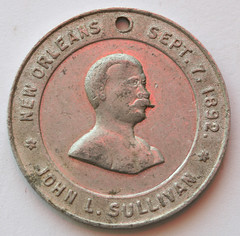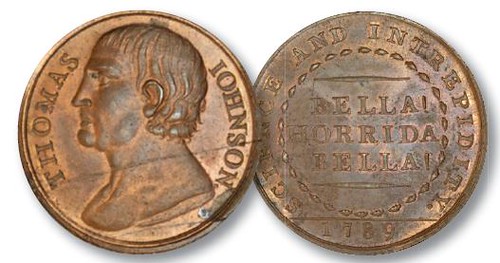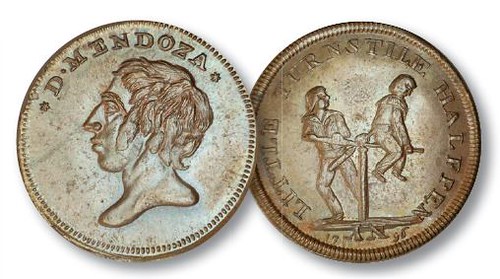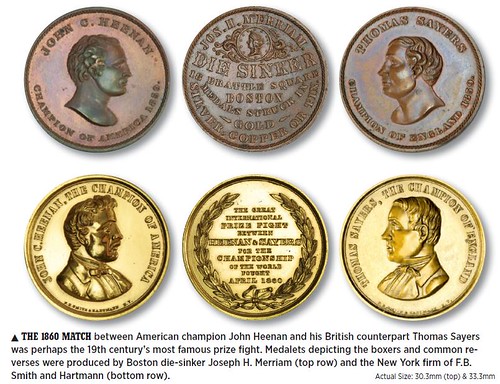
PREV ARTICLE
NEXT ARTICLE
FULL ISSUE
PREV FULL ISSUE
THE NUMISMATICS OF PROFESSIONAL BOXING


Dave Schenkman writes: As a follow-up to the item on John L. Sullivan, attached are pics of a token depicting him. In my article, “Numismatic Mementos of Professional Boxing,” which was published in the June 2015 issue of The Numismatist, I commented that: "A rather plain 29mm aluminum medalet was produced depicting Corbett’s bust on one side with NEW ORLEANS SEPT. 7, 1892, and JAS. J. CORBETT below. The other side is similar, but with a bust of Sullivan and his name. The piece is holed at the top, suggesting that it was worn as a souvenir of the contest. It is listed as number 362 by Eglit who notes that during the Columbian Exposition both men were popular sideshow attractions."
Dave's feature on boxing in numismatics was the cover article that month. Here's an excerpt with some images that caught my eye. Nice items.
-Editor
It is well recorded in literature that the sport of boxing (or the bare-fisted version called “pugilism”) was known in ancient times. In his standard reference Greek Coins and Their Values, David R. Sear lists a silver stater (#5394), struck c. 385-370 B.C., that he describes as picturing “two naked athletes [standing] face to face, their hands raised in the attitude of boxers.” With the fall of the Roman Empire, boxing declined in popularity, and it wasn’t until the early 18th century that it began to evolve into the sport we know today. In the 1700s, pugilism was popular among England’s working class, but was little recognized in the rest of the world until the beginning of the 19th century.

Pugilist Thomas Johnson became champion of England about 1787. His most famous fight took place near Banbury two years later, on October 22, 1789. The brutal 62-round battle, in which he defeated Isaac Perrins, was marked by the issuance of a 34mm copper token. The obverse features a bust of Johnson, while the reverse bears the legend SCIENCE AND INTREPIDITY and date 1789 surrounding BELLA!/HORRIDA/ BELLA! (“Wars! Horrid Wars!” a quote from Virgil’s Aeneid). A companion piece carrying a bust of Isaac Perrins also was struck. Its reverse design is similar to that of the Johnson token, but with the words STRENGTH AND MAGNANIMITY along the perimeter.

England’s boxing champion in 1792-95 was Daniel Mendoza, who is credited with developing a new style of fighting that incorporated defensive moves. Mendoza was 5´7˝ tall and weighed only 160 pounds, but his innovative approach enabled him to prevail over larger and stronger opponents. He was so popular in Great Britain that admission was charged for his third fight, the first time onlookers paid money to watch. Mendoza was immortalized numismatically on a variety of tokens struck in the 1790s. An obverse die featuring his left-facing profile was combined with several reverse dies, undoubtedly to create rare types for collectors of the period. Thomas Spence, a London merchant (and one of the most famous revolutionaries of his time) who described himself as a “bookseller, dealer in prints & coins” on his own advertising tokens, was responsible for these concoctions, which were struck in copper on 29mm planchets.

Be sure to read the complete article in the June 2015 issue of The Numismatist.
-Editor
For more information about the American Numismatic Association, see:
To read the earlier E-Sylum article, see:

Wayne Homren, Editor The Numismatic Bibliomania Society is a non-profit organization promoting numismatic literature. See our web site at coinbooks.org. To submit items for publication in The E-Sylum, write to the Editor at this address: whomren@gmail.com To subscribe go to: https://my.binhost.com/lists/listinfo/esylum All Rights Reserved. NBS Home Page Contact the NBS webmaster 
|